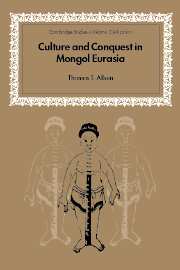Book contents
- Frontmatter
- Contents
- Preface
- Note on transliteration
- Abbreviations
- PART I BACKGROUND
- PART II POLITICAL–ECONOMIC RELATIONS
- PART III INTERMEDIARIES
- PART IV CULTURAL EXCHANGE
- 12 Historiography
- 13 Geography and cartography
- 14 Agriculture
- 15 Cuisine
- 16 Medicine
- 17 Astronomy
- 18 Printing
- PART V ANALYSIS AND CONCLUSIONS
- Bibliography
- Index
- Other titles in the series
18 - Printing
Published online by Cambridge University Press: 04 September 2009
- Frontmatter
- Contents
- Preface
- Note on transliteration
- Abbreviations
- PART I BACKGROUND
- PART II POLITICAL–ECONOMIC RELATIONS
- PART III INTERMEDIARIES
- PART IV CULTURAL EXCHANGE
- 12 Historiography
- 13 Geography and cartography
- 14 Agriculture
- 15 Cuisine
- 16 Medicine
- 17 Astronomy
- 18 Printing
- PART V ANALYSIS AND CONCLUSIONS
- Bibliography
- Index
- Other titles in the series
Summary
The Chinese priority in paper making and printing, as in the case of gunpowder, is well established. The earliest specimens of paper date to the second century BC and following improvements in the second century AD this new writing material came into wide use in China, gradually replacing bamboo, wood slips, and silk in subsequent centuries. According to a tradition well known in Islam, knowledge of paper making reached Samarqand following the Battle of Talas, 751, when Chinese prisoners of war taught the technique to the locals. There was likely a ready market for the new product since Chinese paper had been exported to Samarqand as early as 680. In any event, there was a paper mill in Baghdad by the end of the eighth century and the technology steadily diffused west into North Africa and finally to Europe in the twelfth century.
The history of printing in China, at least in general outline if not in technical detail, is also well known, thanks to the labors of many scholars over the last century. The first plausible literary references to the process of block printing go back to the seventh century AD. The first extant specimens of printing date to the eighth century and the first nearly complete book, the Diamond Sutra of 868, was recovered at Tunhuang. A few years later printed calendars appear. During the Sung dynasty (960–1279) there was a rapid expansion of printing and the formation of a publishing business.
- Type
- Chapter
- Information
- Culture and Conquest in Mongol Eurasia , pp. 176 - 186Publisher: Cambridge University PressPrint publication year: 2001



